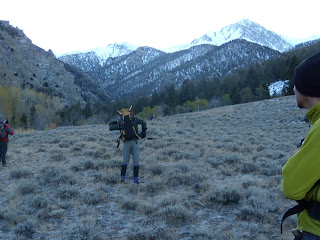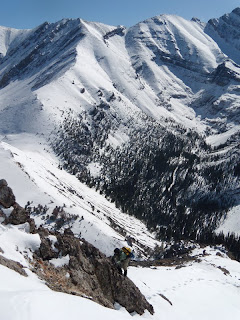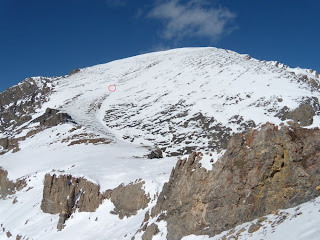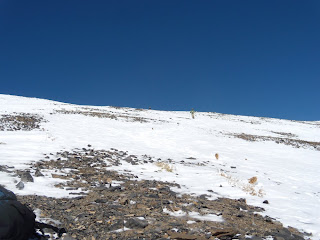Somewhere over the years in migrating to two newer computers, I lost files, important files, files I didn't want to lose. One of the older files I found was this trip report of my climb of Mt. Rainier. I corrected a couple words and deleted a sentence; otherwise, it is the original account written in 2000. A modified version with an assortment of the team's photos lived on the internet on ISU's Outdoor Program website for a long time, but it disappeared before I even thought to copy the photos. So all I have left are the photos pasted in the physical album and the few herein. My hope is to preserve the trip here, and maybe be able to track down and rescue the rest of the photos.
I lived in Bremerton, Washington, from 1983 to 1987. Jeremy was three, and I was primarily a stay-at-home mom. I was an aerobic instructor at the Bangor Military Base, and though I was interested in hiking, I never had any aspirations to climb anything. After all I was from Ohio, and it was already a big deal that I was living out west, let alone participating in any “extreme pursuits.” The first time I had an inkling to climb anything was on a hiking trip to upper Lena Lake. It was a long hike, and maxed out Jeremy, who had to be carried the last 20 minutes. The hike terminated at a small, beautiful alpine lake. Mt. Lena watched over us and appeared to be an easy scramble, albeit exposed. I remember commenting to my (ex-) husband that it would be interesting to climb to the top. He looked at me rather incredulously. So much for that thought.
Mount Rainier, at 14,410 ft, is the most heavily glaciated peak in the contiguous United States. Reaching the summit requires a vertical elevation gain of more than 9,000 ft over a distance of eight or more miles, depending on the route. In 1999, 10,919 people attempted to climb Mount Rainier; 5,255 summited. A large number of ascents are made by Pacific Northwest locals who attempt the 9,000-ft vertical climb from sea level, with varying degrees of success. Other attempts are made by Highpointers, as Rainier is Washington’s highest peak, and international climbers, training for something bigger. To these nonlocals, Rainier is just another peak. Nothing particularly special, just long and unpredictable. But to the “locals,” which I had been, Rainier is so much more. Bruce Barcott, in
Measure of a Mountain, Beauty and Terror on Mount Rainier, states it best:
The local vernacular admits only one “Mountain,” and when Rainier rises we tell each other, “The Mountain is out.” Mount Rainier is at once the most public symbol of the Pacific Northwest and its most sacred private icon. A friend once disclosed that she says a prayer whenever she sees it. A stranger I met on its high southern flank told me, “you must love this mountain as much as I do,” but his reverent tone of voice told me I couldn’t. Lou Whittaker, who has climbed Rainier more than one hundred fifty times, told me about returning home from a Himalayan expedition and catching sight of the mountain, and feeling it snap his breath clean away. …We look at Rainier and regard the vastness of God; yet we look at it and claim it as our own. In 1983, I fell in love at first sight with Rainier; I looked for him everyday; he had become “my” mountain.
I actually had an opportunity to attempt the summit with an outdoor program class at a local community college. I was in excellent physical condition at the time, but had no mountaineering experience. I felt out of my league, and without any friends interested in joining me, I lacked the confidence to go so far as to even sign up for the class. It would not be until 1995, after having summited, with Bob, my first “real” mountain in Idaho, that I expressed to him my interest in climbing this “peak” in Washington State. I think it blew him away when he read about the mountain.
In 1996, I suggested our vacation be to the Pacific Northwest. In all Bob’s travels, it was one area of the country he had not seen. We started in North Bend (off Snowqualmie Pass); traveled to downtown Seattle and explored the city, waterfront, and the infamous Pike’s Place Market; headed to the San Juan islands; stopped over in Victoria, B.C.; crossed over to the peninsula, visited friends in Bremerton; and “swung by” Rainier to climb to base camp and scout things out for a future summit attempt.

Having spent a week at sea level, the climb to Camp Muir, at 10,000 ft, became difficult for me around 9,000 ft. I got a headache, a bad one. When we reached camp, outside of using the rest room, I never moved from my seat on a rock until it was time to descend. I felt better as I made my way down, but also made a mental note to make a summit attempt directly from the higher altitude of Idaho, and save the sea-level sightseeing for later.
In 2000, and less than one week after a successful Mt. Moran summit in Wyoming, Bob and I were on our way to Washington to attempt Rainier with an ISU common adventure group. There were 12 people signed up for the trip, and one leader. Not a good ratio, and earlier that summer I had been advised by friends to consider pulling out of the trip and trying it another year, with a smaller group. I was convinced and tried to change Bob’s mind. But he was very practical about it all. We would go with the group, and if we were not comfortable with the situation then we would break away from the group and attempt the summit together or retreat, whatever was prudent.

We arrived at Paradise Visitor Center/ranger station, on August 7th, and I was sent ahead (because I am slow and I knew where I was going) while Bob waited for ISU’s van. They arrived an hour late, and after a second hour of preparation, Bob and the group headed up behind me. It was beautiful weather, sunny and warm. Bob had left the main group and by mid-afternoon caught up with me, and we climbed the last 1,000 ft together. We set up our camp and by late afternoon everyone else had arrived and set up camp at Muir, where up to 110 people may stay per night
At this point two of the women decided not to make the summit attempt the next morning. One woman had recently had knee surgery and had only intended to get to Muir. Another woman had tried before, gotten sick, and turned her entire group around (it is standard practice for an entire rope team to turn around if one member gets sick). She didn’t want to be responsible for turning another group around, and we were appreciative of her decision.
It was time to group into teams. We wanted to be on a strong team. I felt I could keep myself going, but didn’t know if I could handle being turned around by someone weaker. Fortunately, Bob arranged for us to be on a rope team with Todd, a climber and guide, who drove out from Colorado for this trip. Todd would lead the two of us, and we would be the second of the three teams.
I had read a trail report in the shelter, which I assumed everyone else had seen, that directed climbers to start earlier than normal and be back at camp by 10:00 a.m., because the long period of warm weather had made rockfall/icefall danger extremely high. Therefore, I was voting to leave camp by 10:00 p.m. However, everyone else wanted to wake up at midnight (the standard time) to begin the hike up. So, having been out voted, midnight, August 8th, came and went and it was 1:45 a.m. when our three rope teams joined several other teams for the climb.

Crampons on and ice axes in hands we made our way over and around small crevasses, a 200-ft section of bare rock, and then an aluminum ladder “bridge” that crossed a narrow, but deep (we would see later) crevasse. We jumped over several other crevasses, still in the dark, as we headed toward the Ingraham Direct route. We passed high camp and its sleeping occupants, and we saw an absolutely beautiful and unobstructed view of sunrise on the earth’s east horizon.
We had originally planned to ascend the Disappointment Cleaver route, the most popular route on the mountain, but warm weather, rock and icefall, and detours around crevasses made it a less appealing choice. The Ingraham Direct is a Grade I/II route (strenuous, rock and ice fall, 35 to 40 degree snow and ice slopes, altitude) and had been the most traveled route to the summit in past weeks. A clearly marked, well-defined boot track was in place all the way to the crater rim. This route also avoided the traverse to the Disappointment Cleaver and the notorious rockfall hazard associated with the cleaver. However, the Direct is not the safest route, as it was the scene of a serious accident in early June involving natural, spontaneous icefall. Further, a section of the boot track above Ingraham Flats, we were told, is routinely swept with icefall, even in the morning. Climbing parties were being advised to “move quickly through areas exposed to icefall and seriously consider their level of acceptable risk before exposing their team to objective hazards.” The Ingraham Direct cuts right above 12,000 ft to join up with the Disappointment Cleaver route near the top of the cleaver. Though we had chosen the Ingraham “Direct” route, it required an extra hour detour to circumvent a large crevasse on the upper snowfield.

At 13,000 ft I hit the wall; I was exhausted. This had become the hardest physical effort I had ever undertaken. I had to count my steps...first to 100, but quickly to 50, then only to 30 before stopping a moment to rest...to get my mind off how tired I was and how badly I wanted to sit for awhile. Well, I didn’t have to persevere much longer it turned out, because I should have recalibrated my altimeter at Muir...we reached Columbia Crest and the huge summit crater half an hour later. We dropped our packs, grabbed a snack, and headed across to Rainier’s true summit.
It was truly exciting to be at the top of a mountain that you wanted to climb for a long time. I choked back the lump in my throat and checked out our surroundings. To the south we could see Mts. St. Helens, Adams, Hood, and Bachelor; to the north Baker and Olympus were clear, but Seattle and everything below these peaks was covered from our view with the Pacific Ocean’s motherly blanket of clouds.

We conversed with other climbers; a fellow from Germany took our group pictures. Bob even heard a conversation a fellow in his early 20s was having with his mom on his cellular phone. After telling her he was on the summit of Rainier, Bob heard him tell his mom, “No mom, this is a pretty big mountain; I won’t be home for supper tonight.” We took photos, lots of them, we signed the register (I left my Portage golf tee in the register box), and we crossed the crater to begin our descent to Muir.
It was 11:00 a.m., it was very warm, and from what, apparently, only I had read, we were supposed to back in camp already. The dangerous part of our climb hadn’t occurred yet. We started down.
It was bright, sunny, and very warm. The snow balled under our crampons with each step we took and caused us all to lose our footing and descend in a semislide-step fashion. I noticed at times that my steps landed on very thin patches of glacier that looked like they would break any second, and I pointed them out to Bob behind me.

We had to stop often on our way down so Shane, our leader, could get on his hands and knees and gently probe with his ax to test the integrity of the crossings we’d carefreely plodded over just a few hours before. Seemingly oblivious to the hazards, a couple rope teams loped/ran past us. It seemed inappropriate to go off trail and descend as they were, with the risk of falling into a hidden crevasse at any moment, but they looked like they had a strategy and experience. Their method did not seem to interest any of our team, but their haste caught our attention.

We reached the Ingraham Headwall (which wasn’t the way we planned to come down, but we had missed our turn) at approximately noon. It is a very beautiful but deadly place. You could clearly see the avalanche and rockfall runouts from the headwall, and you could also see that our trail was going to go through them and meander next to them the entire way down. We heard the rumbling of the moving glacier and saw and heard the terror of rockfall, against the peaceful melting of the snow and ice into hidden glacial streams. You could also feel your personal anxiety rise. This was the real thing.
In hindsight, (aside from me sharing the information about leaving early that I had read in the shelter) we should have had a quick group meeting before we entered the headwall area. The conversation should have been very pointed, “See that teeny, tiny spot, way over there? We don’t stop moving through this section until we get there, and we move fast.”

If you’ve ever read
Into Thin Air, or other similar stories, you ask yourself, how did those people get in that situation?…if I were there I would have (fill in the blank). I’ve thought the same, but in reality something very different happens. We stopped three times through this section where objective hazards (snow, ice, and rockfall, and opening crevasses) were in charge. I never knew why we were stopping, but I had no interest in it. I wanted to tell our team, “Let’s pass everyone and get out of here.” I felt, and heard, the same anxiety in others, while I think a few team members had no true idea what a high-risk situation we were in. But in mountaineering the unspoken rules are: we are a team, we have a leader, we follow, we do not ditch the same people we hope will pull our butts out of a crevasse because we did not agree with their pace or the number of stops they make. At the same time, I am in the middle of our rope, and having a running conversation in my head, “What am I going to do if Todd (in front) runs in a different direction than Bob (in back) when this slides?” I could just see myself trapped and suspended in the middle of the path of the slide like a pendant on a necklace. But other than some glacier rumblings and another rockfall event (well away from where we were), we got through to high camp without mishap.

We now approached the crevasses we had jumped over in the dark. They were pretty much the same width, but the snow was much softer and you could see how deep they were. So we jumped with more conviction, axes at the ready, and it was only the last person in our party who broke through the landing that all of us noticed when we jumped was thin. He was prepared and had enough velocity in his jump to keep himself from becoming a crevasse rescue. So, on we went…to the bridge.

It was an 8-ft aluminum ladder with two 1 x 4”s laid over the rungs and all lashed together with webbing. There was a fixed line parallel to it that had functioned as a hand rail, of sorts, that morning. The ladder crossed a crevasse with no bottom. It had been a “never mind” to cross in the dark, but it sure looked different now. The fixed line was no longer secure and not an option to use. Axe still at the ready, my first step on the ladder was a slip, as the snow had balled under my crampons and afforded no footing. I quickly leapt backwards and off the ladder to clear my crampons and try again. The second attempt went better, but unlike earlier that morning, the warm temperatures and the wet wood grabbed the crampons on every step. It was an exciting few steps and I was across, and then so was Bob, and then so was the rest of our party.
I finally breathed.

We returned to Muir where everyone napped, except Bob, who busied himself with putting away gear and cooking. At sunset the winds, of which Rainier is so infamous, picked up and while Bob slept through it all I was pelted with the side of the tent all night.
Before sunrise the wind grew even stronger. Our tent was flapping on both of us and I tried to wake Bob once with my concerns. It wasn’t until the pole snapped and the tent collapsed on us that I fully got his attention. He went outside to check out the situation, but it became clear our only option was to take down the tent and retreat to Rainier’s winter shelter. As we were breaking camp we saw a tent, of a party gone on a summit attempt, blow clear off the mountain. They were not going to be happy when they got back.
Getting to the shelter was no easy task for me. The shelter was only 50 ft away, but in high winds, carrying gear, I literally had to hold on to rocks I passed just to stay upright. Quickly, our whole group tore down camp and became shelter refugees.
We began the second part of our descent in the same high winds, but approximately 1,000 ft lower the winds subsided. Bob skied down the Muir snowfield (rugged as it was) and I tried to glissade, but the snow was too soft and warm. I got going a couple times, but eventually just had to stand back up and trudge. After Bob reached the end of the snowfield he actually climbed back up 1,000 ft to take my pack down, and then he climbed the 1,000 ft again just to ski unencumbered. We completed the hike, down the thousands of stairs (I tried to count them in ’96), and the paved trail, back to the parking lot.
After packing the vehicles, cleaning up, a beer in the bar, and T-shirt shopping, the rest of our group left and Bob and I played “tourists” the rest of the afternoon, watching the Rainier movie, strolling through the exhibits, and looking at the mountain through the periscope in the observation building. I think we really had the full experience, and yes, we’d do it again.





